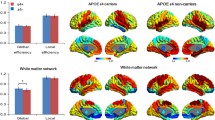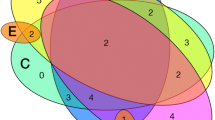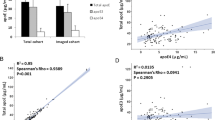Abstract
Purpose
The ε4 allele of the apolipoprotein E (APO-E4) gene, a genetic risk factor for Alzheimer’s disease (AD), also modulates brain metabolism and function in healthy subjects. The aim of the present study was to explore cerebral metabolism using FDG PET in healthy APO-E4 carriers by comparing cognitively normal APO-E4 carriers to noncarriers and to assess if patterns of metabolism are correlated with performance on cognitive tasks. Moreover, metabolic connectivity patterns were established in order to assess if the organization of neural networks is influenced by genetic factors.
Methods
Whole-brain PET statistical analysis was performed at voxel-level using SPM8 with a threshold of p < 0.005, corrected for volume, with age, gender and level of education as nuisance variables. Significant hypometabolism between APO-E4 carriers (n = 11) and noncarriers (n = 30) was first determined. Mean metabolic values with clinical/neuropsychological data were extracted at the individual level, and correlations were searched using Spearman’s rank test in the whole group. To evaluate metabolic connectivity from metabolic cluster(s) previously identified in the intergroup comparison, voxel-wise interregional correlation analysis (IRCA) was performed between groups of subjects.
Results
APO-E4 carriers had reduced metabolism within the left anterior medial temporal lobe (MTL), where neuropathological changes first appear in AD, including the entorhinal and perirhinal cortices. A correlation between metabolism in this area and performance on the DMS48 (delayed matching to sample-48 items) was found, in line with converging evidence involving the perirhinal cortex in object-based memory. Finally, a voxel-wise IRCA revealed stronger metabolic connectivity of the MTL cluster with neocortical frontoparietal regions in carriers than in noncarriers, suggesting compensatory metabolic networks.
Conclusion
Exploring cerebral metabolism using FDG PET can contribute to a better understanding of the influence of genetic factors on cerebral metabolism at both the local and network levels leading to phenotypical variations of the healthy brain and selective vulnerability.


Similar content being viewed by others
References
Strittmatter WJ, Roses AD. Apolipoprotein E and Alzheimer disease. Proc Natl Acad Sci U S A. 1995;92(11):4725–7.
Corder EH, Saunders AM, Strittmatter WJ, Schmechel DE, Gaskell PC, Small GW, et al. Gene dose of apolipoprotein E type 4 allele and the risk of Alzheimer's disease in late onset families. Science. 1993;261:921–3.
Shaw P, Lerch JP, Pruessner JC, Taylor KN, Rose AB, Greenstein D, et al. Cortical morphology in children and adolescents with different apolipoprotein E gene polymorphisms: an observational study. Lancet Neurol. 2007;6(6):494–500.
Burggren AC, Zeineh MM, Ekstrom AD, Braskie MN, Thompson PM, Small GW, et al. Reduced cortical thickness in hippocampal subregions among cognitively normal apolipoprotein E e4 carriers. Neuroimage. 2008;41(4):1177–83.
Donix M, Burggren AC, Suthana NA, Siddarth P, Ekstrom AD, Krupa AK, et al. Longitudinal changes in medial temporal cortical thickness in normal subjects with the APOE-4 polymorphism. Neuroimage. 2010;53(1):37–43.
Magistretti PJ, Pellerin L. Cellular mechanisms of brain energy metabolism and their relevance to functional brain imaging. Philos Trans R Soc Lond B Biol Sci. 1999;354:1155–63.
Samuraki M, Matsunari I, Chen WP, Shima K, Yanase D, Takeda N, et al. Glucose metabolism and gray-matter concentration in apolipoprotein E ε4 positive normal subjects. Neurobiol Aging. 2012;33(10):2321–3.
Reiman EM, Caselli RJ, Yun LS, Chen K, Bandy D, Minoshima S, et al. Preclinical evidence of Alzheimer's disease in persons homozygous for the epsilon 4 allele for apolipoprotein E. N Engl J Med. 1996;334(12):752–8.
Reiman EM, Caselli RJ, Chen K, Alexander GE, Bandy D, Frost J. Declining brain activity in cognitively normal apolipoprotein E epsilon 4 heterozygotes: a foundation for using positron emission tomography to efficiently test treatments to prevent Alzheimer's disease. Proc Natl Acad Sci U S A. 2001;98(6):3334–9.
Reiman EM, Chen K, Alexander GE, Caselli RJ, Bandy D, Osborne D, et al. Functional brain abnormalities in young adults at genetic risk for late-onset Alzheimer's dementia. Proc Natl Acad Sci U S A. 2004;101(1):284–9.
Reiman EM, Chen K, Alexander GE, Caselli RJ, Bandy D, Osborne D, et al. Correlations between apolipoprotein E epsilon4 gene dose and brain-imaging measurements of regional hypometabolism. Proc Natl Acad Sci U S A. 2005;102:8299–302.
Langbaum JB, Chen K, Caselli RJ, Lee W, Reschke C, Bandy D, et al. Hypometabolism in Alzheimer-affected brain regions in cognitively healthy Latino individuals carrying the apolipoprotein E epsilon4 allele. Arch Neurol. 2010;67(4):462–8.
Knopman DS, Jack Jr CR, Wiste HJ, Lundt ES, Weigand SD, Vemuri P, et al. 18F-fluorodeoxyglucose positron emission tomography, aging, and apolipoprotein E genotype in cognitively normal persons. Neurobiol Aging. 2014;35(9):2096–106.
Protas HD, Chen K, Langbaum JB, Fleisher AS, Alexander GE, Lee W, et al. Posterior cingulate glucose metabolism, hippocampal glucose metabolism, and hippocampal volume in cognitively normal, late-middle-aged persons at 3 levels of genetic risk for Alzheimer disease. JAMA Neurol. 2013;70(3):320–5.
Morbelli S, Perneczky R, Drzezga A, Frisoni GB, Caroli A, van Berckel B, et al. Metabolic networks underlying cognitive reserve in prodromal Alzheimer disease: a European Alzheimer disease consortium project. J Nucl Med. 2013;54(6):894–902.
Wilson RS, Bienias JL, Berry-Kravis E, Evans DA, Bennett DA. The apolipoprotein E epsilon 2 allele and decline in episodic memory. J Neurol Neurosurg Psychiatry. 2002;73:672–7.
Caselli RJ, Reiman EM, Osborne D, Hentz JG, Baxter LC, Hernandez JL, et al. Longitudinal changes in cognition and behavior in asymptomatic carriers of the APOE e4 allele. Neurology. 2004;62:1990–95.
Caselli RJ, Reiman EM, Locke DE, Hutton ML, Hentz JG, Hoffman-Snyder C, et al. Cognitive domain decline in healthy apolipoprotein E epsilon4 homozygotes before the diagnosis of mild cognitive impairment. Arch Neurol. 2007;64:1306–11.
Nilsson LG, Adolfcson R, Backman L, Cruts M, Nyberg L, Small BJ, et al. The influence of APOE status on episodic and semantic memory: data from a population-based study. Neuropsychology. 2006;20:645–57.
Ihle A, Bunce D, Kliegel M. APOE epsilon4 and cognitive function in early life: a meta-analysis. Neuropsychology. 2012;26:267–77.
Westlye ET, Hodneland E, Haász J, Espeseth T, Lundervold A, Lundervold AJ. Episodic memory of APOE ε4 carriers is correlated with fractional anisotropy, but not cortical thickness, in the medial temporal lobe. Neuroimage. 2012;63(1):507–16.
Folstein MF, Folstein SE, McHugh PR. "Mini-mental state". A practical method for grading the cognitive state of patients for the clinician. J Psychiatr Res. 1975;2(3):189–98.
Mattis S. Mental status examination for organic mental syndrome in the elderly patients. In: Bellak L, Karasu T, editors. Geriatrics psychiatry: a handbook for psychiatrists and primary care physicians. New York: Grune & Stratton; 1976. p. 77–121.
Reitan RM. Validity of the Trail Making test as an indicator of organic brain damage. Percept Mot Skills. 1958;8:271–6.
Allain P, Nicoleau S, Pinon K, Etcharry-Bouyx F, Barré J, Berrut G, et al. Executive functioning in normal aging: a study of action planning using the Zoo Map Test. Brain Cogn. 2005;57(1):4–7.
Stroop JR. Studies of interference in serial verbal reactions. J Exp Psychol. 1935;18(6):643–62.
Cardebat D, Doyon B, Puel M, Goulet P, Joanette Y. Formal and semantic lexical evocation in normal subjects. Performance and dynamics of production as a function of sex, age and educational level. Acta Neurol Belg. 1990;90:207–17.
Dubois B, Slachevsky A, Litvan I, Pillon B. The FAB: a frontal assessment battery at bedside. Neurology. 2000;55:1621–26.
Wechsler D. Echelle clinique de mémoire de Wechsler MEM-III (WMS-III). Paris: Les éditions du Centre de Psychologie appliquée; 2001.
Grober E, Buschke H, Crystal H, Bang S, Dresner R. Screening for dementia by memory testing. Neurology. 1988;38(6):900–3.
Ergis A-M, Van der Linden M, Deweer B. Investigation of memory performance with a cued recall test in Alzheimer's disease. Rev Neuropsychol. 1994;4:47–68.
Rey A. L’examen psychologique dans les cas d’encéphalopathie traumatique. Arch Psychol. 1941;28:286–340.
Barbeau E, Didic M, Tramoni E, Felician O, Sontheimer A, Joubert S, et al. Evaluation of visual recognition memory in MCI patients. Neurology. 2004;62:1317–22.
Thomas-Antérion C. La mémoire collective, mémoire des événements publics et des célébrités. Les batteries EVE 30 et TOP 30. Marseille: Solal; 2006.
Deloche G, Hannequin D. Test de dénomination orale d'images DO80. Paris: Les Editions du Centre de Psychologie appliquée; 1997.
Benton AL, Sirvan AB, Hamsher D, Varney NR, Spreen O. Facial recognition: stimulus and multiple choice pictures. Contributions to neuropsychological assessment. New York: Oxford University Press; 1983.
Benton AL, Hamsher K, Varney NR, Spreen O. Benton's Judgement of Line Orientation Test. Contributions to neuropsychological assessment. New York: Oxford University Press; 1983.
Gour N, Ranjeva JP, Ceccaldi M, Confort-Gouny S, Barbeau E, Soulier E, et al. Basal functional connectivity within the anterior temporal network is associated with performance on declarative memory tasks. Neuroimage. 2011;58(2):687–97.
Hixson JE, Vernier DT. Restriction isotyping of human apolipoprotein E by gene amplification and cleavage with Hha1. J Lipid Res. 1990;31(3):545–8.
Lieberman MD, Cunningham WA. Type I and Type II error concerns in fMRI research: re-balancing the scale. Soc Cogn Affect Neurosci. 2009;4(4):423–8.
Worsley KJ, Marrett S, Neelin P, Vandal AC, Friston KJ, Evans AC. A unified statistical approach for determining significant signals in images of cerebral activation. Hum Brain Mapp. 1996;4:58–73.
Lee DS, Kang H, Kim H, Park H, Oh JS, Lee JS, et al. Metabolic connectivity by interregional correlation analysis using statistical parametric mapping (SPM) and FDG brain PET; methodological development and patterns of metabolic connectivity in adults. Eur J Nucl Med Mol Imaging. 2008;35(9):1681–91.
Braak H, Braak E. Neuropathological stageing of Alzheimer-related changes. Acta Neuropathol. 1991;82(4):239–59.
van der Flier WM, Schoonenboom SNM, Pijnenburg YAL, Fox NC, Scheltens P. The effect of APOE genotype on clinical phenotype in Alzheimer disease. Neurology. 2006;67:526–7.
Lee KU, Lee JS, Kim KW, Jhoo JH, Lee DY, Yoon JC, et al. Influence of the apolipoprotein E type 4 allele on cerebral glucose metabolism in Alzheimer's disease patients. J Neuropsychiatry Clin Neurosci. 2003;15(1):78–83.
Mosconi L, Nacmias B, Sorbi S, De Cristofaro J, Fayazz M, Tedde A, et al. Brain metabolic decreases related to the dose of the ApoE e4 allele in Alzheimer's disease. J Neurol Neurosurg Psychiatry. 2004;75(3):370–6.
Mosconi L, Herholz K, Prohovnik I, Nacmias B, De Cristofaro MTR, Fayyaz M, et al. Metabolic interaction between ApoE genotype and onset age in Alzheimer's disease: implications for brain reserve. J Neurol Neurosurg Psychiatry. 2005;76(1):15–23.
Wisdom NM, Callahan JL, Hawkins KA. The effects of apolipoprotein E on non-impaired cognitive functioning: a meta-analysis. Neurobiol Aging. 2011;32:63–74.
Alexander DM, Williams LM, Gatt JM, Dobson-Stone C, Kuan SA, Todd EG, et al. The contribution of apolipoprotein E alleles on cognitive performance and dynamic neural activity over six decades. Biol Psychol. 2007;75:229–38.
Small BJ, Rosnick CB, Fratiglioni L, Bäckman L. Apolipoprotein E and cognitive performance: a meta-analysis. Psychol Aging. 2004;19:592–600.
Minoshima S, Frey KA, Koeppe RA, Foster NL, Kuhl DE. A diagnostic approach in Alzheimer's disease using three-dimensional stereotactic surface projections of fluorine-18-FDG PET. J Nucl Med. 1995;36(7):1238–48.
Shinohara Y, Hirase H, Watanabe M, Itakura M, Takahashi M, Shigemoto R. Left-right asymmetry of the hippocampal synapses with differential subunit allocation of glutamate receptors. Proc Natl Acad Sci U S A. 2008;105(49):19498–503.
Loewenstein DA, Barker WW, Chang JY, Apicella A, Yoshii F, Kothari P, et al. Predominant left hemisphere metabolic dysfunction in dementia. Arch Neurol. 1989;46:146–52.
Johnson KA, Jones K, Holman BL, Becker JA, Spiers PA, Satlin A, et al. Preclinical prediction of Alzheimer’s disease using SPECT. Neurology. 1998;50:1563–71.
Thompson PM, Hayashi KM, de Zubicaray G, Janke AL, Rose SE, Semple J, et al. Dynamics of gray matter loss in Alzheimer's disease. J Neurosci. 2003;23(3):994–1005.
Meunier M, Bachevalier J, Mishkin M, Murray EA. Effects on visual recognition of combined and separate ablations of the entorhinal and perirhinal cortex in rhesus monkeys. J Neurosci. 1993;13:5418–32.
Aggleton JP, Vann SD, Denby C, Dix S, Mayes AR, Roberts N, et al. Sparing of the familiarity component of recognition memory in a patient with hippocampal pathology. Neuropsychologia. 2005;43(12):1810–23.
Mishkin M, Suzuki WA, Gadian DG, Vargha-Khadem F. Hierarchical organization of cognitive memory. Philos Trans R Soc Lond B Biol Sci. 1997;352(1360):1461–7.
Caselli RJ, Graff-Radford NR, Reiman EM, Weaver A, Osborne D, Lucas J, et al. Preclinical memory decline in cognitively normal apolipoprotein E-epsilon4 homozygotes. Neurology. 1999;53:201–7.
Gour N, Felician O, Didic M, Koric L, Gueriot C, Chanoine V, et al. Functional connectivity changes differ in early and late-onset Alzheimer's disease. Hum Brain Mapp. 2014;35(7):2978–94.
Deary IJ, Whiteman MC, Pattie A, Starr JM, Hayward C, Wright AF, et al. Cognitive change and the APOE epsilon 4 allele. Nature. 2002;418(6901):932.
Wilson RS, Schneider JA, Barnes LL, Beckett LA, Aggarwal NT, Cochran EJ, et al. The apolipoprotein E epsilon 4 allele and decline in different cognitive systems during a 6-year period. Arch Neurol. 2002;59:1154–60.
Caselli RJ. Age-related memory decline and apolipoprotein E e4. Discov Med. 2009;8(41):47–50.
Schiepers OJ, Harris SE, Gow AJ, Pattie A, Brett CE, Starr JM, et al. APOE E4 status predicts age-related cognitive decline in the ninth decade: longitudinal follow-up of the Lothian Birth Cohort 1921. Mol Psychiatry. 2012;17(3):315–24.
Arriagada PV, Growdon JH, Hedley-Whyte ET, Hyman BT. Neurofibrillary tangles but not senile plaques parallel duration and severity of Alzheimer's disease. Neurology. 1992;42:631–9.
Gomez-Isla T, Hollister R, West H, Mui S, Growdon JH, Petersen RC, et al. Neuronal loss correlates with but exceeds neurofibrillary tangles in AD. Ann Neurol. 1997;41(6):809–13.
Braak H, Del Tredici K. The pathological process underlying Alzheimer's disease in individuals under thirty. Acta Neuropathol. 2011;121(2):171–81.
Didic M, Barbeau EJ, Felician O, Tramoni E, Guedj E, Poncet M, et al. Which memory system is impaired first in Alzheimer's disease? J Alzheimers Dis. 2011;27(1):11–22.
Wolk DA, Manning K, Kliot D, Arnold SE. Recognition memory in amnestic-mild cognitive impairment: insights from event-related potentials. Front Aging Neurosci. 2013;5:89. doi:10.3389/fnagi.2013.00089.
Parra MA, Abrahams S, Logie RH, Mendez LG, Lopera F, Della SS. Visual short-term memory binding deficits in familial Alzheimer’s disease. Brain. 2010;133:2702–13.
Kahn I, Andrews-Hanna JR, Vincent JL, Snyder AZ, Buckner RL. Distinct cortical anatomy linked to subregions of the medial temporal lobe revealed by intrinsic functional connectivity. J Neurophysiol. 2008;100:129–39.
Das SR, Pluta J, Mancuso L, Kliot D, Orozco S, Dickerson BC, et al. Increased functional connectivity within medial temporal lobe in mild cognitive impairment. Hippocampus. 2012;23:1–6.
Bookheimer SY, Strojwas MH, Cohen MS, Saunders AM, Pericak-Vance MA, Mazziotta JC, et al. Patterns of brain activation in people at risk for Alzheimer’s disease. N Engl J Med. 2000;343:450–56.
Fleisher AS, Houston WS, Eyler LT, Frye S, Jenkins C, et al. Identification of Alzheimer disease risk by functional magnetic resonance imaging. Arch Neurol. 2005;62:1881–88.
Bondi MW, Houston WS, Eyler LT, Brown GG. fMRI evidence of compensatory mechanisms in older adults at genetic risk for Alzheimer disease. Neurology. 2005;64:501–8.
Han SD, Houston WS, Eyler LT, Salmon DP, Fleisher AS, Bondi MW. Verbal paired-associate learning by APOE genotype in nondemented older adults: fMRI evidence of a right hemispheric compensatory response. Neurobiol Aging. 2006;28:238–47.
Heun R, Freymann K, Erb M, Leube DT, Jessen F, Kircher TT, et al. Mild cognitive impairment (MCI) and actual retrieval performance affect cerebral activation in the elderly. Neurobiol Aging. 2007;28:404–13.
Garrido GE, Furuie SS, Buchpiguel CA, Bottino CM, Almeida OP, Cid CG, et al. Relation between medial temporal atrophy and functional brain activity during memory processing in Alzheimer’s disease: a combined MRI and SPECT study. J Neurol Neurosurg Psychiatry. 2002;73:508–16.
Compliance with ethical standards
None.
Conflicts of interest
None.
Funding
This study was funded by AP-HM (PHRC 2007/09) and supported by INSERM (Centre d’Investigation Clinique, CIC, Hôpital de la Conception, Marseille), as well as the association “Déchaîne ton cœur”. M. Didic received a Marie Curie grant from the European Commission (BMH4CT965032).
Research involving human participants and/or animals
All procedures performed in studies involving human participants were in accordance with the ethical standards of the institutional and/or national research committee and with the principles of the 1964 Declaration of Helsinki and its later amendments or comparable ethical standards. A committee on human experimentation of the institution and the local institutional committee approved this study (registration number NCT00484523).
Informed consent
Informed consent was obtained from all participants included in the study.
Author information
Authors and Affiliations
Corresponding author
Rights and permissions
About this article
Cite this article
Didic, M., Felician, O., Gour, N. et al. Rhinal hypometabolism on FDG PET in healthy APO-E4 carriers: impact on memory function and metabolic networks. Eur J Nucl Med Mol Imaging 42, 1512–1521 (2015). https://doi.org/10.1007/s00259-015-3057-y
Received:
Accepted:
Published:
Issue Date:
DOI: https://doi.org/10.1007/s00259-015-3057-y




